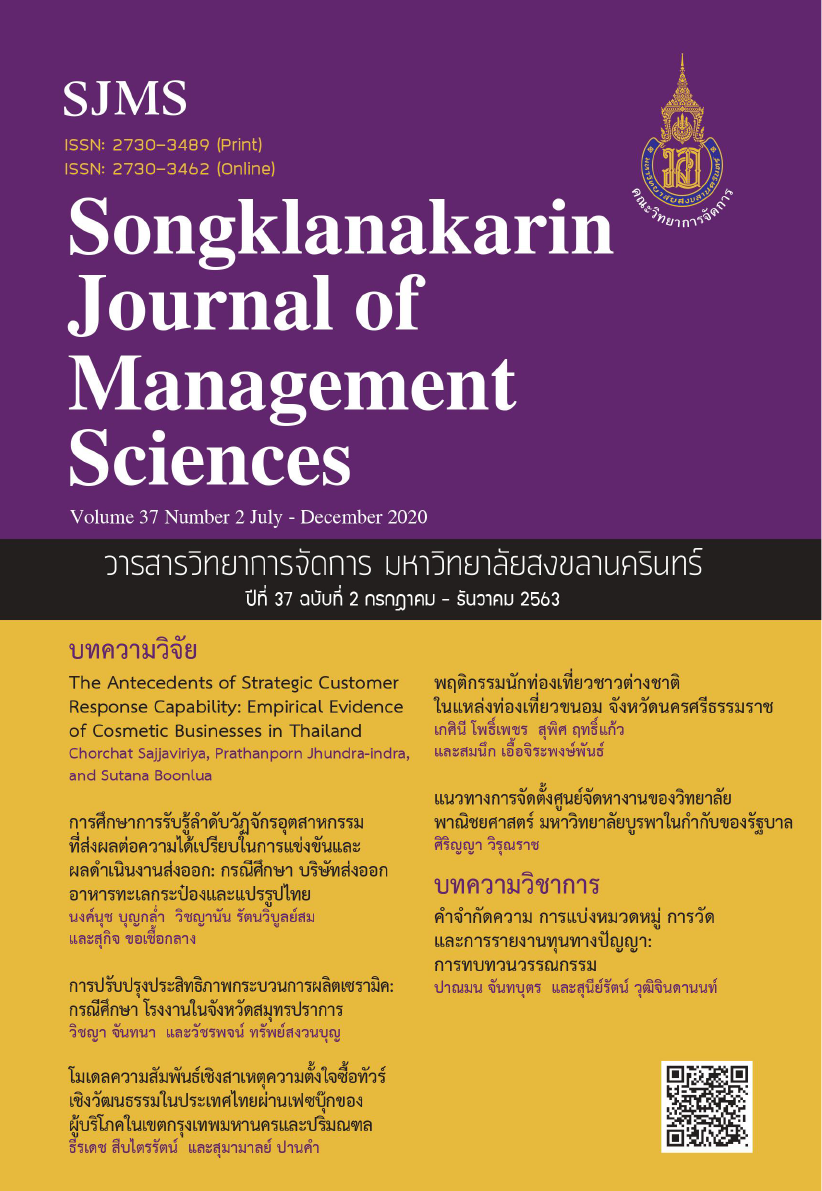Productivity Improvement in Ceramic Production Process: A Case Study of Factory in Samut Prakan Province
Main Article Content
Abstract
The objective of this study is to analyze problems caused by the ceramic production process of a case study of a ceramic company in Samut Prakan Province by using the Supply Chain Operations Reference: SCOR Model and to propose alternative solutions to increase the efficiency of the ceramic production process. The Supply Chain Operations Reference (SCOR Model) is used as a framework for data collection by observing and studying work processes from actual work operations together with the analysis with the Flow Process Chart, Flow diagram, Value Added (VA) and Non Value Added (NVA) activities, including the necessary and unnecessary activities in conjunction with the ECRS (Eliminate, Combine, Rearrange and Simplify) which is the principles to identify waste and unnecessary steps from the process and find ways to improve it. The result shows that there are 3 and 16 wasteful activities in the planning and production processes respectively. Therefore, the solution to reduce waste in the planning and production processes by reducing cycle time. The result of research shows that the planning process and production process after the improvement has been reduced the cycle time 17.16 hours and 5.87 hours respectively. This solution can produce more pieces per day and increase work efficiency which is beneficial to the business operations in the future.
Article Details

This work is licensed under a Creative Commons Attribution-NonCommercial-NoDerivatives 4.0 International License.
All published articles are SJMS’s copyright. The editorial board allows all published articles to be copied, excerpted, or disseminated with academic citation.
References
Akkharaprathomphong, A. (2009). Waste Reduction by using ECRS. Retrieved November 15, 2020, From https://cpico.wordpress.com/2009/11/29/%e0%b8%81%e0%b8%b2
APICS. (2017). Quick Reference Guide SCOR Supply chain Operation Reference Model. Retrieved April 18, 2020, From https://www.apics.org/docs/default-source/scc-non-research/apicsscc_scor_quick_reference_guide.pdf
Baimai, C. & Trongwattanawuth, S. (2018). PRODUCTIVITY IMPROVEMENT FOR SMALL ORGANIC RICE MILLS IN CHIANG MAI PROVINCE USING SCOR MODEL. RMUTT Global Business and Economics Review, 13(1), 123-138.
Chantharat, M. & Maikaensarn, V. (2019). UPSTREAM SUPPLY CHAIN ANALYSIS OF SANGYOD MUANG PHATTHALUNG RICE USING SCOR MODEL. Panyapiwat Journal, 11(1), 127-138.
Crawford. (2016). 5 Lean Principles Every Engineer Should Know. Retrieved April 20, 2020, From https://www.asme.org/topics-resources/content/5-lean-principles-every-should-know
Homthong, P. (2013). 7 Watses. Retrieved November 15, 2020, from http://www.thailandindustry.com/indust_newweb/articles_preview.php?cid=19136
Jinagool, D. (2015). Lean Concept. Retrieved April 20, 2020, from http://ird.sut.ac.th/irdnew/Files/IRD/KM/Lean_16march2015.pdf
Kaohoon. (2019). BREAKING NEWS. Retrieved April 20, 2020, from https://www.kaohoon.com/content/299199
Kesama, P. (2002). Root Cause Analysis by Fishbone Diagram. Management Best Practices. Retrieved November 15, 2020, from http://www.tqmbest.com/knowledge_base/5article/0TQM_Foundation/2QC_Story_Kaizen_5-S/MBP_V.9-4.pdf
Kingkaew, C. (2005). Development of Production Processes Management System for Dried Parawood. Master of Engineering Thesis in Industrial Engineering Prince of Songkla University.
Pongsuwan, R. (2018). Efficiency Improvement work in process applying of production, the principle of ECRS case study in P.C. TAKASHIMA Co., Ltd. Master of Science Program Independent study in Industrial Management Rajabhat Rajanarindra University.
Poonket, W. (2014). Management System for delivery case study: Well Steel Business Co., Ltd. Cooperative Education Project in Industrial Engineering Siam University.
Sapsanguanboon, W., & Auanguai, P. (2019). The Application of Supply Chain Process Using Supply Chain Operations Reference (SCOR) Model: Case Study of a Public Company in Thailand. Burapha Journal of Business Management, 8(2), 89-102.
Singhtaun, Ch. (2010). Process Analysis. Retrieved November 15, 2020, from https://pirun.ku.ac.th/~fengcsr/courses/2008_01/206341/ch8.pdf
Sonthimoon, P. (2018). Modern ceramics and creating added value for products. OIE Share, 7(14), 9-11.
Sunarak, Th. (2016). Production line efficiency improvement: The case study of powder product packing line. Thai Industrial Engineering Network Journal, 2(3), 51-60.
Thailand Environment Institute. (2012). Lean Management for Environment Ceramic Industry. Retrieved November 15, 2020, from http://www.tei.or.th/trainingdow/leanbook/Lean%20for%20Ceramic.pdf
The Office of Industrial Economics. (2019). Ceramic Industry. Retrieved February 25, 2020, from http://www.oie.go.th/assets/portals/1/fileups/2/files/Industry%20conditions/annual2019trends2020.pdf
Wajanawichakorn, K., Srisawat, P., & Thippo, W. (2016) Efficiency Improvement of the Pottery Production Process to Reduce Waste and Increase the Production Quality: Case Study of HUAYWANGNONG Pottery Group, Ubonratchathani. UBU Engineering Journal, 9(2), 38-46.
Warawonghiran, K. (2016). Process Efficiency Improvement for automotive parts production line. Master of Science Program Thesis in Logistics and Supply Chain Management Program Faculty of Logistics Burapha University.

